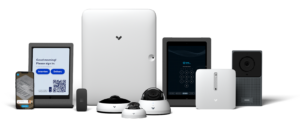Introduction to Access Control Technology
In today's rapidly evolving digital landscape, ensuring the security of our physical and digital spaces has become paramount. New access control technology plays a pivotal role in safeguarding these spaces, from office buildings to data centers. In this blog, we'll explore the various aspects of access control technology, its evolution over the years, and its growing importance in modern security systems.
Importance of Access Control in Security Systems
Access control serves as the first line of defense in protecting sensitive areas and information. New access control technology is crucial in mitigating security risks significantly. Unauthorized access can lead to data breaches, theft, and even physical harm, making access control an indispensable component of any comprehensive security strategy.

Evolution of Access Control Technology Over the Years
Access control technology has come a long way from traditional lock and key systems. Today, it encompasses a wide array of cutting-edge solutions, each designed to meet specific security needs. From key cards to biometric authentication and cloud-based systems, the evolution of new access control technology has been marked by constant innovation and adaptation to new challenges.
Integration of Biometrics
One of the most exciting developments in new access control technology is the integration of biometrics. This technology utilizes unique physical traits like fingerprints, facial features, and iris scans for authentication.
Use of Fingerprints, Facial Recognition, and Iris Scans for Authentication
Biometric access control systems provide an unprecedented level of security by relying on the uniqueness of each individual's biometric data. Unlike passwords or key cards, new access control technology using biometrics ensures a robust choice for access control.
Advantages of Biometric Access Control Systems
The advantages of new access control technology based on biometrics extend beyond security. These systems offer convenience, as there's no need to remember passwords or carry access cards. Additionally, they reduce the risk of identity theft and unauthorized access, enhancing overall security.
Mobile Access Control
With the proliferation of smartphones, mobile access control has gained immense popularity.
Utilization of Smartphones as Access Credentials
Mobile access control allows users to use their smartphones as digital keys, granting access to secured areas or resources. This new access control technology not only enhances convenience but also improves flexibility, as permissions can be easily granted or revoked remotely.
Benefits of Mobile Access Control in Terms of Convenience and Flexibility
Mobile access control powered by new access control technology simplifies the management of access permissions, streamlines the onboarding process for new users, and ensures that access is only granted to authorized individuals, all while leveraging the devices we carry with us daily.
Cloud-Based Access Control
Cloud-based access control solutions have transformed the way organizations manage access.
Storing Access Control Data and Settings on the Cloud
New access control technology in the form of cloud-based systems stores access data and settings in secure cloud servers, offering real-time accessibility from anywhere. This approach eliminates the need for on-premises infrastructure and allows for seamless updates and scalability.

Advantages of Cloud-Based Access Control
The advantages of new access control technology using the cloud include remote management, scalability, and reduced maintenance costs. Organizations can easily adapt their access control systems to evolving needs without major infrastructure investments.
Artificial Intelligence in Access Control
Artificial intelligence (AI) has ushered in a new era of access control technology.
Implementation of AI Algorithms for Enhanced Security
New access control technology incorporating AI algorithms is used to analyze access patterns, detect anomalies, and prevent unauthorized access. By continuously learning and adapting, AI-based access control systems provide a higher level of security than traditional methods.
Role of AI in Detecting Anomalies and Preventing Unauthorized Access
AI's ability to identify suspicious activities and patterns enables organizations to proactively address potential security threats. It enhances security without adding complexity to the user experience.
Internet of Things (IoT) Integration
The integration of access control systems with the Internet of Things (IoT) brings about automation and efficiency improvements.
Connecting Access Control Systems with Other IoT Devices
IoT integration powered by new access control technology allows access control systems to communicate with other IoT devices, such as security cameras and environmental sensors. This interconnectedness enables smarter and more responsive security measures.
Benefits of IoT Integration for Improved Automation and Efficiency
New access control technology enhanced by IoT integration enhances automation, enabling access control systems to respond to changing conditions in real-time. For example, doors can be locked or unlocked based on occupancy or environmental factors, optimizing both security and energy efficiency.
Blockchain Technology for Access Control
Blockchain technology offers a tamper-proof and secure way to manage access records.
Utilizing Blockchain for Secure and Tamper-Proof Access Records
Blockchain's decentralized and immutable nature makes it ideal for recording access events. Access records stored on the blockchain are resistant to tampering, ensuring transparency and accountability.
Advantages of Blockchain in Preventing Fraud and Ensuring Transparency
Blockchain technology provides an unforgeable audit trail, reducing the risk of fraud and disputes. It also enhances trust by allowing stakeholders to verify access records independently.
Enhanced Analytics and Reporting
Data analytics plays a crucial role in monitoring access patterns and identifying potential risks.
Utilization of Data Analytics to Monitor Access Patterns and Identify Potential Risks
New access control technology that incorporates data analytics enables access control systems to detect unusual access patterns, enabling security teams to take prompt action. By analyzing access data, organizations gain valuable insights into their security posture.
Importance of Detailed Reporting for Compliance and Auditing Purposes
Detailed reporting is essential for compliance with regulations and for conducting thorough security audits. Access control systems that provide comprehensive reports powered by new access control technology help organizations meet their compliance requirements.
Conclusion and Future Prospects
As we've explored the various facets of new access control technology, it's clear that this field is constantly evolving. From biometrics to AI, IoT, and blockchain, access control technology continues to advance, offering increasingly robust and intelligent security solutions.
Recap of the Top New Access Control Technology Trends
We've witnessed how new access control technology has evolved and diversified to meet the challenges of modern security needs. Biometrics, mobile access, cloud-based solutions, AI, IoT integration, and blockchain have all played pivotal roles in shaping the landscape.
Speculation on Potential Advancements and Innovations in the Coming Years
Looking ahead, we can expect even more exciting developments in new access control technology. Innovations like quantum-resistant encryption and improved integration with smart devices will continue to enhance security and convenience.
Founded in 2001 and headquartered in Irvine, California, BCS is a woman-owned (SWBE) and minority-owned (SMBE) licensed C7 low-voltage cabling and audiovisual contractor. BCS’ robust portfolio includes: AV and video conference solutions, room automation, structured cabling, wireless infrastructure, IT networking, CCTV surveillance, command and control centers, access control, paging and life safety, sound masking and more. While other AV companies and cable contractors in Irvine may be limited to servicing local clients, BCS sets itself apart by successfully deploying rollouts locally and nationwide for an array of solutions we design in-house.

New access control technology is an essential component of modern security systems, and its ongoing evolution promises to keep our physical and digital spaces safer than ever before. As businesses and organizations continue to prioritize security, new access control technology will remain at the forefront of their efforts to protect their assets, employees, and customers.
For businesses and organizations in Irvine, California, new access control technology solutions are readily available to help you secure your premises and data. Whether you're looking to implement the latest biometric access control systems, leverage the convenience of mobile access, or explore cloud-based solutions, Irvine offers a range of options to meet your specific security needs. Stay ahead of security threats and take advantage of the latest new access control technology to safeguard your assets and maintain peace of mind. Call us at +1 949-333-1000 for more information.
FAQs
- What is new access control technology, and why is it important?
- New access control technology refers to advanced security systems that utilize cutting-edge solutions such as biometrics, AI, and IoT integration. It's crucial because it enhances security by providing more robust authentication methods, real-time monitoring, and tamper-proof access records, helping protect against unauthorized access and security breaches.
- How does biometric access control work, and what are its advantages?
- Biometric access control uses unique physical traits like fingerprints, facial features, and iris scans for authentication. Its advantages include heightened security, as biometric data is difficult to duplicate, and added convenience for users who no longer need to remember passwords or carry access cards.
- What benefits does IoT integration offer in access control systems?
- IoT integration in access control systems connects them with other IoT devices such as security cameras and environmental sensors. This integration enhances automation and efficiency by enabling access control systems to respond in real-time to changing conditions, optimizing both security and energy efficiency.


You must be logged in to post a comment.